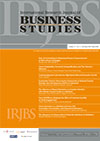Employee Engagement in A Remote Working Scenario
DOI:
https://doi.org/10.21632/irjbs.14.2.119-127Keywords:
Remote worker, Employee Engagement, Practice, Productivity, CrisisAbstract
Remote working is a concept in which the employees do not commute or travel to the Organizations place of work but allows the employees to work outside of the traditional office environment. Employee engagement can be viewed as an attitude of an employee/employee’s a to be productive, to excel and therefore be committed towards the organisation. Remote working applies to a variety of employees especially office or desk-based workers. This paper explores different facets of the remote worker’s persona and provides recommendations and practices to enhance employee engagement of the employees working remotely. Remote work culture is not a new concept, but due to the current Covid-19 Pandemic situation there seems to be a rapid shift of many employees to the remote working model essentially working away from the traditional office ecosystem. This paper examines two aspects of working remotely, a. In regular times b. during a crisis and in both these scenarios how to keep the remote workers engaged and motivated to ensure a minimum if not zero loss of Productivity.
References
Chanana, N., & Sangeeta. (2020). Employee engagement practices during Covid-19lockdown. Journal of Public Affairs, September. https://doi.org/10.1002/pa.2508
Chandani, A., Mehta, M., Mall, A., & Khokhar, V. (2016). Employee engagement: A review paper on factors affecting employee engagement. Indian Journal of Science and Technology, 9(15). https://doi.org/10.17485/ijst/2016/v9i15/92145
Dixit, A. R., & Singh, S. (2020). Understanding drivers of engagement from employee’s perspective during COVID-19. International Journal of Management, 11(10), 943–959. https://doi.org/10.34218/IJM.11.10.2020.087
Gaurav, J. (2020). Draw Closer To Your Employees in Times of Social Distancing: Suggestive Framework for Employee Engagement During Lockdown Due To (Covid-19) https://doi.org/10.13140/RG.2.2.22377.31849
Hrmagazine, K., & Winter, A. (2020). Measuring Employee Engagement During a Crisis. Winter, 1–6.
Kumar, A., & Kapoor, S. (2020). Employee Engagement Amidst Covid-19 pandemic: A Challenge or Opportunity for Indian Organisations. International Journal of Advanced Science and Technology, 29(9 Special Issue), 1980–1987. https://www.scopus.com/inward/record.uri?eid=2-s2.0-85085104276&partnerID=40&md5=3c5887b5b4d90d72008917b39f0bbe22
Pattnaik, L., & Jena, L. K. (2020). Mindfulness, remote engagement, and employee morale: conceptual analysis to address the “new normal.” International Journal of Organizational Analysis. https://doi.org/10.1108/IJOA-06-2020-2267
Saji, B. S. (2014). Employee Engagement and Its Role during Crisis Management: A Conceptual Model. European Journal of Business and Management, 6(19), 110–117. http://iiste.org/Journals/index.php/EJBM/article/view/13730
Yadav, S., Dubey, A., Chawla, P., & Abvsme, J. (2020). Employee Engagement Strategy for Employees Working in Virtual Environment in the IT Industry. 03, 1–11.
Downloads
Submitted
Published
How to Cite
Issue
Section
License
Copyright (c) 2021 Anoor Ashwini Anand, Sheetal N. Acharya

This work is licensed under a Creative Commons Attribution-ShareAlike 4.0 International License.
Journal Author(s) Rights
For IRJBS to publish and disseminate research articles, we need publishing rights (transferred from the author(s) to the publisher). This is determined by a publishing agreement between the Author(s) and IRJBS. This agreement deals with the transfer or license of the copyright of publishing to IRJBS, while Authors still retain significant rights to use and share their own published articles. IRJBS supports the need for authors to share, disseminate and maximize the impact of their research and these rights, in any databases.
As a journal Author, you have rights to many uses of your article, including use by your employing institute or company. These Author rights can be exercised without the need to obtain specific permission. Authors publishing in IRJBS journals have comprehensive rights to use their works for teaching and scholarly purposes without needing to seek permission, including:
- use for classroom teaching by Author or Author's institution and presentation at a meeting or conference and distributing copies to attendees;
- use for internal training by the author's company;
- distribution to colleagues for their research use;
- use in a subsequent compilation of the author's works;
- inclusion in a thesis or dissertation;
- reuse of portions or extracts from the article in other works (with full acknowledgment of the final article);
- preparation of derivative works (other than commercial purposes) (with full acknowledgment of the final article);
- voluntary posting on open websites operated by the author or the author’s institution for scholarly purposes,
(But it should follow the open access license of Creative Common CC-by-SA License).
Authors/Readers/Third Parties can copy and redistribute the material in any medium or format, as well as remix, transform, and build upon the material for any purpose, even commercially. Still, they must give appropriate credit (the name of the creator and attribution parties (authors' detail information), a copyright notice, an open access license notice, a disclaimer notice, and a link to the material), provide a link to the license, and indicate if changes were made (Publisher indicates the modification of the material (if any) and retain an indication of previous modifications.
Authors/Readers/Third Parties can read, print and download, redistribute or republish the article (e.g. display in a repository), translate the article, download for text and data mining purposes, reuse portions or extracts from the article in other works, sell or re-use for commercial purposes, remix, transform, or build upon the material, they must distribute their contributions under the same license as the original Creative Commons Attribution-ShareAlike (CC BY-SA).
This work is licensed under a Creative Commons Attribution-ShareAlike 4.0 International License.








